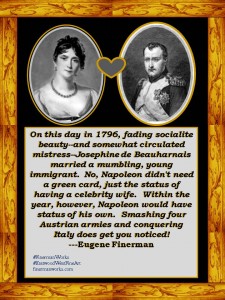January 11, 1927: Louis B. Mayer Wants To Feel Classy
Every year you torment yourself with the question “Will I really watch the Academy Awards again?” There are good reasons to do so. First, if you are a masochist, the gratification would be obvious: hours of stupefying boredom mixed with irritating attempts at entertainment. Then, there is the cultural obligation. If these people are “stars”, shouldn’t you know who they are? (Mastering the distinction between Shia LaBoeuf and Emile Hirsch could earn you the respect of teenagers!) And, those of us of a graying age have a morbid fascination seeing how our past favorites now look: who still are glamorous and who should sue their plastic surgeons?
Of course, you will want to hear the speeches. If nothing else, you will feel so superior. The usual speech at the Oscars is terrible: incoherent, rambling and too often neurotic. Surprisingly, most of the speeches are only 45 seconds in length; they do seem so much longer. Indeed, the Academy tries to impose a time limit on the speakers. Notice how the orchestra begins playing the 46th second of a speech, just as the year’s winning set designer is thanking his acupuncturist. If the speaker ignores that hint, one of those smiling models–who likely has a black belt in karate– will subtly pinion his arms and nudge him off stage. But despite this terror-imposed punctuality, a two-hour ceremony somehow lasts four hours or so.
Consider the irony: if our movies were as bloated and misdirected as the Oscars ceremony, Hollywood might still be orange groves near a small city named Los Angeles. Yet, Hollywood is one of the great and enduring success stories of America. In 1906, the perennial sunshine of Southern California was conducive for shooting film and tempted a New York-based studio to open a west coast office. Even then, filmmakers had a tendency to copy each other. By 1915, most American movies were made in California, and an agricultural community outside of Los Angeles had become the center and synonym for movies.
The world loved Hollywood’s films. Charlie Chaplin, Mary Pickford and Douglas Fairbanks by themselves ensured a trade surplus for America. As for the producers and studio heads–Louis B. Mayer, Cecil B. DeMille, Samuel Goldwyn and others–they were rich and powerful but still dissatisfied. Men of modest origins but not modest natures, they wanted honors and deference. In another time or country, they could have acquired titles of nobility; but 20th century America had none to offer. However, in 20th century America these producers were free to anoint themselves. So they did. On January 11, 1927 Louis B. Mayer announced the formation of a society whose chief purpose was self-adoration. Grasping for prestige, the organization’s name was the Academy of Motion Pictures Arts and Sciences. Its first president was the preeminent leading man of the day: the popular and presentable Mr. Fairbanks. (His divorces were amicable.) As befits any prestigious Academy, there would be annual awards for merit.
The first awards ceremony was at a banquet in May, 1929. Fourteen awards were given out in 15 minutes. We would recognize most of the awards’ categories: best film, best actor, best actress, best director, etc. But the prize for “Best Title Writing” requires some explanation. Movies were silent, and any narration or dialogue would appear on title cards flashing on the screen. So, when the villain wants to have his way with Lillian Gish, a title card would express Miss Gish’s indignation: “You cad!” The first award for best Title Writing was also the last. In 1927’s”The Jazz Singer” Al Jolson had turned to the audience and said aloud, “You ain’t heard nothing yet.” The Hollywood film now talked.
The tradition of the terrible acceptance speech also dates to that first Awards ceremony. The winner for best actor was Emil Jannings. He was German but in silent films no one could detect his miserable knowledge of English. The advent of the “talkie”, however, ended his prospects in Hollywood. He actually was on a train out of town when the first Awards ceremony was held. Jannings wired his acceptance speech, saying thank you and adding “I therefore ask you to kindly hand me now already the statuette award for me.”
Of course, Hollywood could not resist filming itself. The highlights of each ceremony were compiled and distributed as news reels to be shown in movie houses around the world. Until 1952, that was the only way the public saw the Oscars; and through the wonders of editing, every winner was concise, eloquent and sober. So the public never heard Greer Garson’s acceptance speech after she won Best Actress of 1942 for her performance in “Mrs. Miniver.” Not even a transcript has survived, so only as legend and rumor is it remembered as the longest and worst speech in the history of the Academy Awards. According to the Guinness Book of Records, Miss Garson spoke for nearly six minutes. She began, “I’m practically unprepared” and then commenced a broad philosophical meandering about the nature of film. No one could remember the details; amnesia can be a mercy. Until Miss Garson, the Academy never thought of imposing a time limit on speakers. After her, the limit was set at 45 seconds.
Yet, as you can see on YouTube, some strange speeches did elude editing. Winning best actress for 1935, Bette Davis seems more vengeful than grateful. “I am very pleased: everyone who voted for me at the Academy and all the people who have wished this year that I get it.” In fact, Miss Davis was nursing a grudge. In 1934, she had received critical praise and popular acclaim for her performance in “Of Human Bondage.” Yet, the Academy had failed even to nominate her. The omission caused such an outcry that the Academy was cowed into an unprecedented concession: it would permit write-in votes for Best Actress. She still failed to win; however, the next year the Academy was wise enough to give the formidable Miss Davis the award for a film with a very accurate title: “Dangerous.”
At least Bette Davis was being Bette Davis. In 1940, Vivien Leigh sounded like the prototype of the Stepford Wife. Awarded Best Actress for her performance as Scarlett O’Hara, Miss Leigh said, ” Ladies and Gentlemen. Please forgive me if my words are inadequate in thanking you for your very great kindness. If I were to mention all those who have shown me wonderful generosity through “Gone With the Wind” I should have to entertain you with an oration that is as long as “Gone With the Wind” itself. So if I may, I should like to devote my thanks on this occasion to that complefied figure of energy, courage and very great kindness in whom all points of “Gone With the Wind” meet, Mr. David Selznick.”
Such fulsome praise of a producer is not unusual, and it might even be mandatory in an Oscar speech. In fairness, if any producer actually deserved that idolatry, Selznick did. Through his constant and tireless work, he really did produce “Gone With the Wind.”; and it was his gut instincts to cast a minor English starlet as Scarlett O’Hara. But Vivien Leigh’s speech is so artificial and stiff; it is practically embalmed. Consider the use of the word “complefied”; it is a form of the Latin past participle for complete. Who in the audience would have understood it except some priests and professors–very few of whom were at the Academy Awards that night. Like the speech itself, the word is contrived and pretentious. Furthermore, Miss Leigh seems uncomfortable in her recitation, as if she were the hostage of the speechwriter. Perhaps she was, and the culprit was her fiancé at the time: Laurence Olivier.
Olivier certainly knew what sounded Shakespearean but had not quite mastered the coherence. Thirty-nine years later, he had not improved. Upon receiving a Lifetime Achievement Academy Award, Lord Olivier expressed his thanks: “In the great wealth, the great firmament of your nation’s generosities this particular choice may perhaps be found by future generations as a trifle eccentric, but the mere fact of it–the prodigal, pure human kindness of it–must be seen as a beautiful star in that firmament which shines upon me at this moment, dazzling me a little, but filling me with warmth of the extraordinary elation, the euphoria that happens to so many of us at the first breath of the majestic glow of a new tomorrow.” The words are lofty and poetic; with Olivier’s magnificent voice, the speech sounds wonderful. It just does not make the least sense. And since Olivier was being broadcast live on television, he could not be edited into a passable semblance of reason.
Television has given the Oscars a worldwide audience and the winners the temptation to say whatever they want. We will hear their political opinions and learn the names of their agents, children and high school English teachers. Some will charm us with their wit, but more will amaze us with their lack of it. Others will mistake us for psychoanalysts and divulge neuroses we didn’t want to know. Of course, we will wonder why we are watching and make a determined resolution not to look next year. We made the same vow last year.


